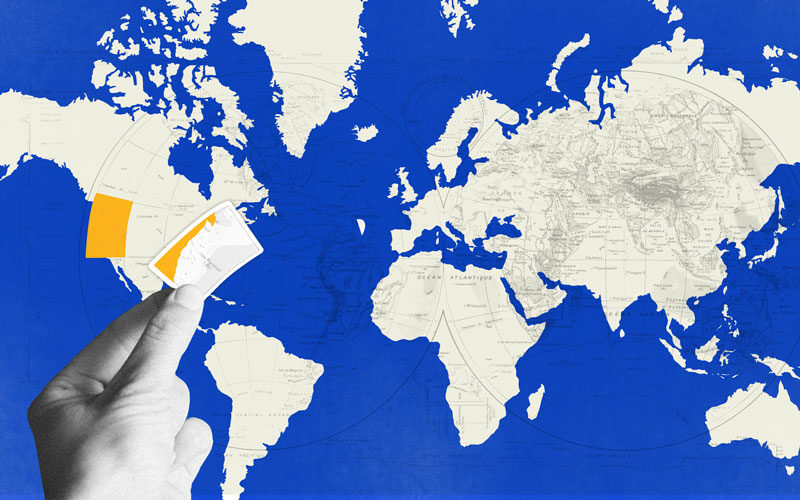There’s been a shift in the Valley.
It’s the end of a decades-long, hot summer for the Bay Area. Tech workers are packing up for slower paces and greener pastures. Industry has moved away from the good old honest work of making microchips – 2022 is all about “lower-value” offerings like advertising, digital marketing, and ethically dubious data collection. Silicon C-suites are quitting the Big Four to seek their (next) fortunes in blockchain.
With the Valley well and truly over the hill, where will the next global innovation hub be? Is the era-defining startup culture of the 80s and 90s exportable? Will the birthplace of Apple, Google, and Meta – the cradle of civilization as we know it – ever be replicated?
The mother of invention
The first question we need to ask about a new global tech hub is: do we need one?
Far from the strictly localised innovation of the 20th century – and thanks to it – innovation now operates across global airwaves.
One: people have proven they can be just as productive at home. Two: the world is still fractured by post-pandemic practices. We may not need to hold events and conferences remotely, but we’re used to it. And a pretty major three: company travel means travel emissions. Jetting in from Frankfurt or San Fran means a mark on the carbon balance sheet, and the furore over celebrity airmiles is only making “unnecessary” travel more conspicuous.
On all counts, it seems safer to stay home.
But wouldn’t it be a shame to say sayonara to collaborative work? The pandemic also gave life to entrepreneurship, innovation, a new drive for discovery. We – okay, some of us – missed each other during lockdowns. We still have our humanity.
Is it enough to inspire a new global contender to replace the brilliant and bizarre Bay Area? Who might that be? And for argument’s sake, let’s exclude New York, San Fran, and London – they’ve had their chance.
Tel Aviv, Israel
International population: 26%
Israeli unicorns: 92
We took a deep dive on Tel Aviv’s startup scene when it took the number one spot in 2021’s Global Startup Ecosystem Index.
Just 9 miles across in certain places, Israel’s first working day of the week is Sunday. But in a move that symbolised the country’s openness to global adaptation and foreign investment, the founder Roy Mann named his project management SaaS startup ‘Monday’ and the company is now worth USD $6.18 billion.
WeWork, eToro, Payoneer, Sisense, Avant Houzz, and Wix were all built by Israeli founders. Forward thinking, huge government investment, the “chutzpah” baked into the culture, and perhaps even the completion of national service by all citizens all combine to create a world-leading stable for unicorns.
Lisbon, Portugal
International population: 20%
Portuguese unicorns: 7
When Portugal’s richest man Antonio Champalimaud died, he left €500 million of his cement-made fortune to the creation of the Centre for the Unknown, an otherworldly limestone complex on Libon’s waterfront built to solve humanity’s greatest health challenges.
The neighbouring port area Beano is being transformed into an innovation hub for 3000 people, nicknamed the “Unicorn Factory” by Mayor Carlos Moedas. Moedas understands the lifestyle element of locating a business, essential especially to younger founders and the digital nomads they employ, saying: “People come to a city not because of innovation, but because of a cultural scene.”
Thanks to the cultural scene it has in spades – and probably the business, beer, and beaches lifestyle – Lisbon is Europe’s 4th most popular startup hub after Berlin, London, and Barcelona.
A London to Lisbon pipeline is emerging as founders desert the “ruinous” British capital for lower costs, freer movement, and a slower, sunnier pace.
Mammoth Analytics (“big data for dummies”) CEO Gaurav Dudhoria moved the firm from London to Lisbon to take advantage of the “low cost structure [that] allows breathing room to fail”. Seek founder Alannah Ross made the same move to take advantage of the talent pool (40% of Lisbon grads studied business or engineering). Satore founder Tupac Martir needed a place to accommodate his 35 staff from 27 different countries after Brexit. He considered Amsterdam, Berlin, Milan, and Copenhagen before being sold by Lisbon’s “golden visa scheme” for non-EU nationals.
7 unicorns is small fry compared to Israel’s numbers, but FarFetch, OutSystems and Talkdesk have already lit the torch.
Bangalore, India
International population: 50%
Indian unicorns: 105
Bangalore has long been a major outsourcing hotspot. Already India’s biggest IT hub, it has over 30 Special Economic Zones dedicated to aerospace and biotech and an abundance of skilled software devs. Work on making its CBD smart is already underway, and the city has jumped from 74th to 48th place in India’s Smart Cities Mission rankings. Everyone who’s anyone has offices there – the Big Four in tech, the Big Four in consulting, plus IBM, Intel, Siemens, and Oracle.
Bangalore has a young (35% aged 15-35) and hugely diverse (roughly 50% immigrant) population. It also has a pro-startup government.
Bangalore has already produced 14 full-unicorn startups including Flipkart, Ninjacart, and Razorpay, and is touted as home to more “soonicorns” than the major cities of Mumbai and Delhi combined.
There’s just one pretty sharp thorn in Bangalore’s side – just 24% of women are in work, the lack of diversity and exclusion of a huge potential talent pool undoubtedly inhibiting Bangalore’s attempt at startup glory.
Surrey Hills, Australia
International population: 48%
Australian unicorns: 6
Corporate Australia is going in on the “work, but not as we know it” mentality.
In-office activity is still alive and kicking (or attempting to be revived) with the development of actually-appealing workplaces, CBDs, and if you’re Atlassian, “habitats”.
Flying bravely in the face of the WFH movement, Atlassian is spending $1.4 billion to set up shop in Surry Hills, making them the anchor tenant of Tech Central. Its “Team Anywhere” workforce will have the option to stay home or innovate – in a sustainable and worker-friendly way – IRL.
Triangulated by the University of NSW, University of Sydney, and University of Technology, the latter of which has 350 active startups in its specialist program, Surrey Hills is already home to unicorns Afterpay, Canva, and SafetyCulture, and a swathe of global VC firms including Blackbird Ventures, Grok Ventures, and King River Capital.
KRC founder and Silicon Valley vet Zeb Rice says of Tech Central: “There’s this frisson – this kind of effervescence of ideas and innovation and disruption and startups, and I think Surry Hills is experiencing that.”
The stage can’t be set without VC, but support seems to be strong. Rice says: “We used to invest about 78% of our money in the US, raised mostly from Australia. It’s now about 50/50. I never thought we would put so much money to work here…. But we’re finding absolutely world-class companies just down the street.”
A few hundred miles north, the GC is also stoking the startup flames. It’s offering “up to $2.5 million in cash rebates for capital investments, up to 10% reimbursement of operating expenditure, and up to $10,000 per eligible employee or job created”.
1 in 5 GC residents already works for themselves.
In Queensland, Greater Springfield is a “masterplanned” community, bought for $6 million in 1992 and slated to become Australia’s first net-zero city (by 2038).
Sections of the greenfield space like the Knowledge Precinct and Health City are designed to attract 52,000 new workers by 2030.
The investment is there. The question is whether we Aussies can imitate America’s kind of annoying yet indomitable entrepreneurial spirit to keep the momentum going.
A question of purity
There’s something kind of cynical about trying to copy and paste a cultural movement.
No one went to Santa Clara and said “let’s turn this place into a global tech hub”. It happened organically, starting as a military research epicentre; transformed by Stanford dean Frederick Terman’s regionalistic vision to provide workspaces and jobs; and bolstered by bright graduates from the nearby Universities of California and Berkeley.
Terman introduced Bill Hewlett to Dave Packard who then worked with Steve Jobs. The network of people who built the networks of the world were intricately connected. Today, over 2000 firms can be traced back to a connection with one of the eight original founders of Silicon Valley’s first venture capital firm, Fairchild.
And this is another key point: pockets of innovation can only be built with deep pockets.
The vast amount of venture capital that built the world’s IT infrastructure was self-proliferating. In Fairchild founder Gordon Moore’s words: “Every time we came up with a new idea, we spawned two or three companies trying to exploit it.”
Entrepreneurs became investors and then entrepreneurs again. Startups spawned investment firms. Out of the 2000 companies traced back to the OG generation of VCs, 92 are publicly listed today, and alone are worth over USD $2 trillion.
No measly government startup grants needed there.
A case for human contact
Say what you will about what the Bay Area has become. This hivemind of human ingenuity was a social phenomenon we may never see again.
Perhaps bleaker than a future without new tech hubs is a future where togetherness is expendable.
Just because we can work “together” remotely, doesn’t mean we should. There are still many arguments to be made for being in the same room.
Some interesting stats taken amidst rolling global lockdowns in 2021:
- 22% of workers felt WFH hurt their creativity
- 28% of C-suite managers “struggled to innovate and devise creative solutions”
- 22% of managers blamed the loss of visual, in-person brainstorming.
With the influx of virtual whiteboarding tools like Figma and Miro, paired with screen sharing, this should be a non-issue. But we haven’t adapted well to virtual collaboration, with:
- Only 41% of remote workers saying virtual tools helped them innovate
- 37% saying the tools’ constant notifications actually disrupted their ability to be creative
- 24% of management reporting ideas got lost without centralised note-taking.
There’s nothing to say we can’t be creative virtually, we just prefer to do it in IRL. There’s the convenience-led stuff like shopping and filing taxes that we’re happy to do via screens. But as with a lot of more human things – socialising, dating, creating – we prefer the human touch.
It would be myopic to suggest this applies to all jobs – service and hospitality workers would probably love to put the odd shift in from their sofas. But for the passionate founders and innovators and their engaged and ambitious teams, it would be a tragedy to condemn the energy and excitement of Silicon Valley’s early days to the past.
The likelihood is that the “next” Silicon Valley will be remote – but it will be underpinned by real, thriving global communities, working together to share the wealth and save the planet.
And if there is another city that takes the crown, let’s just hope it’s not in America again.











